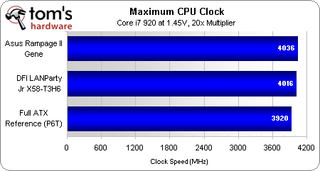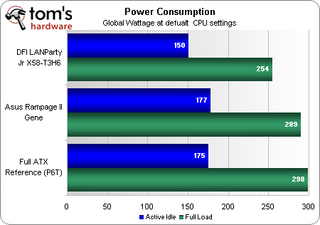Asus And DFI: Core i7 Micro-ATX Motherboards Compared
Overclocking, Power And Heat
Though available Core i7 processors are typically limited to around 220 MHz BCLK, a few select samples can at least exceed that limit. Extreme overclockers, especially though with sub-ambient cooling, will also try higher voltage levels than most of us would consider safe. Here’s what the two Micro ATX Core i7 motherboards offer in BIOS.
| BIOS Frequency And Voltage Settings (For Overclocking) | ||
|---|---|---|
| Asus Rampage II Gene | DFI LANParty Jr X58-T3H6 | |
| CPU Base Clock | 100-500 MHz (1 MHz) | 133-250 MHz (1 MHz) |
| CPU Multiplier | Yes | Yes |
| DRAM Data Rates | BCLK x6 - x16 (x2) | BCLK x6 - x16 (x2) |
| PCIe Clock | 100-200 MHz (1 MHz) | 100-250 MHz (1 MHz) |
| CPU Vcore | 0.85-2.50V (6.25mV) | 1.00-2.00V (12.5mV) |
| Uncore Voltage | 1.20-2.50V (6.25mV) | 1.21-1.61V (10mV) |
| IOH Core | 1.11-2.20V (13.25mV) | 1.10-1.45V (50mV) |
| ICH Core | 1.11-2.20V (13.25mV) | 1.05-1.35V (100mV) |
| DRAM Voltage | 1.51-2.50V (13.25mV) | 1.455-2.40V (15mV) |
| CAS Latency | 3-11 Cycles | 1-11 Cycles |
| tRCD | 3-10 Cycles | 1-31 Cycles |
| tRP | 3-10 Cycles | 1-10 Cycles |
| tRAS | 3-31 Cycles | 1-31 Cycles |
While the Rampage II Gene offers a broader range of Bclk and voltage settings, the LANParty Jr X58-T3H6’s BIOS limits still exceed the tolerable levels for available hardware.
The toughest test is to see how far each motherboard can stably push our Core i7 920 processor using the same voltage settings and timings. We used eight threads of Prime95 x64 to stress each configuration.

The Rampage II Gene beat the LANParty Jr X58-T3H6 in top clock speed at 1.45V core, but not by enough to consider a definitive victory. More significant is that both Micro-ATX motherboards proved more stable than the full-sized Asus P6T, invalidating myths about Micro-ATX incapacity.

A base clock of 220MHz could potentially take a Core i7 920 to 4.40 GHz, but only with a very good core and advanced cooling. A lower multiplier allowed us to bypass those special conditions to find a retail processor’s Bclk limit on each motherboard, just shy of the 220 MHz mark for both the LANParty Jr X58-T3H6 and Rampage II Gene. Both motherboards beat the full-sized P6T, again putting to rest notions about Micro ATX instability.

DFI wins the memory overclocking comparison. The second-place Rampage II Gene beats the full-sized P6T on average due to its much higher six-module results, but the P6T rises to the middle when only three modules are installed.

Asus alters the standard voltage level slightly in addition to its 0.20% default CPU overclock, but the increase in power is still somewhat surprising. Our most recent experience has shown that most motherboards typically fall between the LANParty Jr X58-T3H6 and Rampage II Gene in power consumption when using these components, so DFI deserves about half the credit for the significant disparity in power consumption.
Stay on the Cutting Edge
Join the experts who read Tom's Hardware for the inside track on enthusiast PC tech news — and have for over 25 years. We'll send breaking news and in-depth reviews of CPUs, GPUs, AI, maker hardware and more straight to your inbox.

In spite of its higher power consumption, the Rampage II Gene runs slightly cooler than LANParty Jr X58-T3H6.
Current page: Overclocking, Power And Heat
Prev Page Benchmark Results: Synthetics Next Page Conclusion-
IzzyCraft Shame the DFI board didn't do better it help shut up people going where is the Rampage II gene in the Builders marathon.Reply
Although this review let me have a little more respect for the board I'm still asus and gigabyte all the way. -
Proximon Really nice article! BIOS screenshots are so important when helping someone configure their board on line, and we do a lot of that around here. I thought you hit all the major points and I especially like the conclusion format.Reply -
andy_mcp1 Great article. About time the facts were laid on the table. I've not quite got to upgrading to I7 M-Atx yet, but got an Asus P5E-VM (not the best admittedly) and an E8400 which on air is oc'd to 4.1Ghz stable (for the past 8 months), which I’ve on countless occasions used to show my mates who have full atx systems that bigger isn’t always better as my 3dmark and pcmark scores were better than theirs (of comparable full sized board builds).Reply
Good point, and I agree, that the hardest thing for the market is for those who have idealisms that the atx board with the most slots are best, have to admit that this not the case, that they don’t need and wont likely use them. It’s about time technology moved on and we start shrinking the components. We've come a long way from house sized computers but seems to have got stuck with fridge-sized atx, time to change that and join the 21st century! -
doomtomb The prices between the DFI and Asus are nearly the same, a difference of $20 or $30. The Asus Rampage II Gene wins it in my opinion.Reply -
SpadeM For me, it's about the features and backplate I/O ports not the performance, when it comes to motherboards with the same chipset. The differences between them is so little that it doesn't matter in real life. Plus given the fat that motherboards, like processors, aren't identical I might get one that performs lower/better then what's in this review.Reply -
Crashman IzzyCraftShame the DFI board didn't do better it help shut up people going where is the Rampage II gene in the Builders marathon.Although this review let me have a little more respect for the board I'm still asus and gigabyte all the way.Reply
Really, the reason the Rampage II Gene wasn't considered for the $2500 PC is that it didn't show up under a Newegg category search (LGA-1366, Micro ATX) and Newegg didn't fix that until this week. It's a good board, and if you need a weird cooler style, supports the more popular LGA-775 coolers. -
atamanroman I like it that uatx is getting more and more attention, since my own i7 uatx cube project is only a few weeks away.Reply
but im missing the MSI X58M (160€ best prive vs 198€ asus and 190 dfi) here, theres a great review at anandtech. the board really rocks and has only a few weak points (fan control and s3 wake up problem if overclocked). i think ppl would be glad if the msi could be added to this comparison.
best regards,
roman -
zehpavora Very good article, but I think that the components chosen should be from the same time frame, because I think that the P6T is "too old" compared to the GENE board. Maybe the P6T V2 would be a better idea. Now I fear the Mini-ATXs.Reply -
avatar_raq Nice article..I wonder if you were planning on it for a while or you wrote it in response to our comments in the SBM..And yeah it showed what I always expect from ASUS; top notch mobos.Reply
P eople go for a full atx build simply because they can (:P), and because larger cases offer better cooling especially for SLI and CF, it's much easier to build and, other than portability, there is no real advantage of a micro-atx build, even the price difference is not worth it in my opinion. But the article does a good job of showing that u-atx boards can be excellent performers. -
Onus Excellent article. Any differences between those boards are molehills, not mountains.Reply
Personally, I'd probably give up a tiny bit of performance for the more noteworthy reduction in power used by DFI; I like the cooler flexibility of the Asus though. It would be a tough call.
Most Popular


